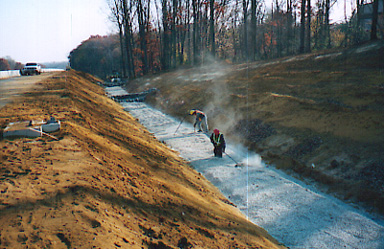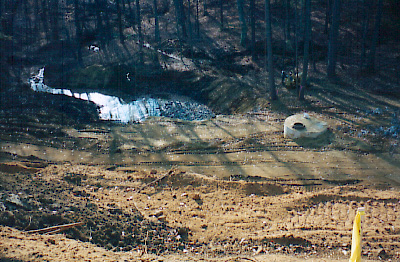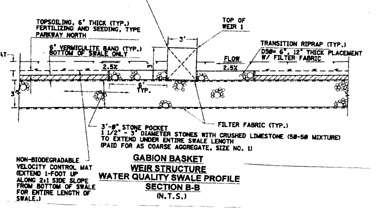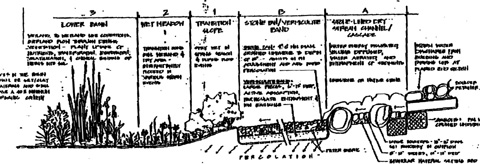Increasingly engineers, landscape architects, and design professionals are seeking ways to comply with Phase II of the National Pollution Discharge Elimination Program (NPDEP), various local, state, and federal requirements of the Water Pollution Control Act, and many state laws and regulations promulgated to control of water pollution and storm water pollution.

NJ Parkway |

|
For years "point source" pollution and so-called "non-point source" pollution from industrial sites have been carefully regulated and managed, but soon many "non-point sources" from other than industrial sites will have to comply with best management practices for storm water run-off.
Perlite and vermiculite have been used in a number of storm water management systems and designs.
Because they both can absorb and adsorb a lot of water and because they can also improve drainage capabilities even when holding water, they both have been used when it is desirable to hold back water and give it time to more naturally drain away or be filtered. And because vermiculite has some interesting cation exchange capabilities, it has been used when heavy metals may be polluting storm water and need to be removed before the water is discharge into streams or rivers. For instance, there have been several designs for large parking lots and highways where the storm water is channeled through vermiculite to collect some of these pollutants.
In other landscaping/storm water designs, perlite has been added to the soil in "bio-filters" and special retention ponds to both absorb excess water and increase drainage into the natural aquifer.
In still other applications, perlite and vermiculite have been used as filtration media in commercial storm water filtration systems. In these units, the filters and filtration media have to be recharged, cleaned, or replaced from time to time---but still some of the filtration properties of perlite and vermiculite have been used.
In "green roofs" and "roof-top gardens" perlite also is being used to lighten the soil mixes and help retard the run off of waste amounts of storm water. (read more at Greenroofs and Green Roof Technology )
As more and more situations demand more creative designs, both of these minerals will play an increasing role. What we have shown here is just one of many projects and designs.
What we have below are a few of the plans being used:
- DETAILS OF THE WATER QUALITY SWALE PICTURE ABOVE
- A BIOFILTER DESIGN ( from NJDEP's Technical Manual for Land Use Regulation Program--September 1997)
- A BIOFILTER DETAIL PLAN (from a recent development project)
DETAILS OF THE WATER QUALITY SWALE PICTURE ABOVE

In the designs of the NJ Parkway exit ramp pictured above, the lower section was a three by three foot layer of 1 1/2" to 3" diameter stones with crushed limestone (50-50 mixture) extending under the entire swale.
On top of that was filter fabric followed by a 6 inch "band" or layer of coarse expanded vermiculite. On top of the vermiculite was more filter fabric with a 6 inch think layer of topsoil on top.
A BIOFILTER DESIGN (FROM NJDEP)

flows through several layers of natural and artificial filters before entering the basin area (center of picture) and then flowing eventually to a stream in the lower left corner |

It then flows across large stones for aeration and some filtration (A), then across section B that is a "stone and vermiculie band." This consists of placing a filter fabric on the bottom (or coarse perlite could be used) followed by a layer of vermiculite (six to 12 inches on the bottom), filter fabric, and then a layer limestone on top. Section 1 is the "transiton slope" followed by the "wet meadow" area (2) before the lower basin (3) or retention basin. The "stone and vermiculite band" is used to adjust the pH of the water (limestone), to to aid in percolation, followed by active absorbtion, particulate entrapment, and ion exchange (coming from the vermiculite---vermiculite has a very high cation exchange capacity and has been used to "entrap" heavy metal ions.) |
A BIOFILTER DETAIL

|
In this situation, storm water had to be filtered down a fairly steep slope before discharging into a stream. The 20'x20' bio filter included the use of 8 inches of vermiculite, covered by 8 inches of limestone, covered by 8-12 inches of natural stone (with layers of a filter fabric between each layer.)
On the "downside" of each bio filter is an 8 inch "check dam". The end result is water retention and filtration. |
For more information about stormwater management designs, go to
- Biofiltration Basins.
- The Stormwater Manger's Resource Center ---The Stormwater Manager's Resource Center (SMRC) web site is made possible through a grant from the Environmental Protection Agency, Office of Water, Office of Wastewater Management, Assistance Agreement #828077-01. The SMRC site is managed and published by the Center for Watershed Protection, Inc., a 501(c)3 organization located in Ellicott City, Maryland.
- An EPA Report entitled: "Evaluating Innovative Stormwater Management Technologies Under the Environmental Technology Verification (EVT) Program"
For more information about these uses of perlite in gardening, Greenroofs, turf grass applications, landscaping, and container growing see our main horticultural page , please call or contact us at:
The Schundler Company
10 Central Street
Nahant, MA 01908
(ph)732-287-2244
www.schundler.com
email: info@schundler.com
Back to Horticultural Main Page